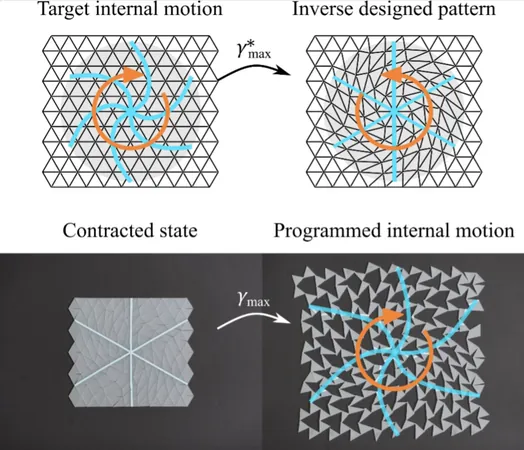
Revolutionizing Kirigami: A Game-Changing Simplified Design Method
2025-05-25
Author: Ming
Kirigami, the fascinating traditional Japanese art of cutting and folding paper, has evolved from an artistic endeavor into a powerful tool for innovation in physics, engineering, and materials science. It's now used to create everything from advanced materials to robotic systems, pushing the boundaries of what's possible.
A Breakthrough in Inverse Design Methodology
Researchers at Sichuan University and McGill University are turning heads with their groundbreaking approach to inverse engineering in kirigami. Their revolutionary method, recently published in *Physical Review Letters*, sidesteps the complexity of numerical algorithms, simplifying the design process for intricate kirigami structures and opening up a world of real-world applications.
Senior author Damiano Pasini shared insights, noting how this project builds on their previous work. "This work is a natural extension of our earlier explorations into kirigami's mechanics," he explained. Ph.D. student Chuan Qiao played a vital role, focusing on the snapping interactions within thin shells and the unique anisotropic morphing capabilities of kirigami.
Unlocking the Secrets of Kirigami Design
The researchers focused on understanding how geometric factors, such as the angles and lengths of slit patterns, influence kirigami's behavior during deployment. By observing the transformation in shapes during the final deployment, they initiated a series of pivotal questions about how changing the overall shape of a rotating unit could lead to different deformations.
With these inquiries in mind, their quest crystallized into two main goals: to unveil the fundamental connection between rotating units and the resulting kirigami shapes, and to utilize this discovery to design kirigami without relying on complex numerical methods.
A Simple Yet Elegant Solution
Their findings revealed an intriguing correlation between the strain applied to rotating units and the subsequent deformation of deployed triangle kirigami. This relationship paves the way for a much simpler inverse design methodology.
"What's fascinating is that the shear strain affecting the original rotating units, which contract horizontally, aligns inversely to the shear strain of the resulting deployed kirigami, which expands horizontally," Pasini added.
Utilizing this insight allows for intuitive geometric adjustments to achieve targeted shapes during deployment, ultimately eliminating the need for extensive computation.
Key Ingredients for Success
The essence of this new design technique involves three crucial components: the contracted shape of the rotating units, the final deployed shape of the kirigami, and an area-preserving map to navigate the transformation between the two forms.
By utilizing these elements, researchers can engineer the shear strain of deployed triangle kirigami quickly and efficiently, offering remarkable versatility in design.
Demonstrating Potential Across Applications
To showcase their innovative method, Pasini and his team successfully crafted three types of morphing targets—including the contracted shape, the deployed shape, and the internal motion trajectories of rotating units within the kirigami.
This groundbreaking study elucidates a fundamental relationship between kirigami’s deformation and the shapes of its rotating units, laying the groundwork for designing highly adaptable structures. The geometric approach promises to create a spectrum of kirigami designs capable of addressing complex engineering challenges.
Looking Ahead
Pasini concluded, "This work offers fundamental insights into the transformation of materials with rotating units, providing an intuitive route for rapidly designing sophisticated kirigami structures. The principles observed here could similarly inform explorations into quadrilateral kirigami and other complex patterns, highlighting the vast potential of our findings."


 Brasil (PT)
Brasil (PT)
 Canada (EN)
Canada (EN)
 Chile (ES)
Chile (ES)
 Česko (CS)
Česko (CS)
 대한민국 (KO)
대한민국 (KO)
 España (ES)
España (ES)
 France (FR)
France (FR)
 Hong Kong (EN)
Hong Kong (EN)
 Italia (IT)
Italia (IT)
 日本 (JA)
日本 (JA)
 Magyarország (HU)
Magyarország (HU)
 Norge (NO)
Norge (NO)
 Polska (PL)
Polska (PL)
 Schweiz (DE)
Schweiz (DE)
 Singapore (EN)
Singapore (EN)
 Sverige (SV)
Sverige (SV)
 Suomi (FI)
Suomi (FI)
 Türkiye (TR)
Türkiye (TR)
 الإمارات العربية المتحدة (AR)
الإمارات العربية المتحدة (AR)